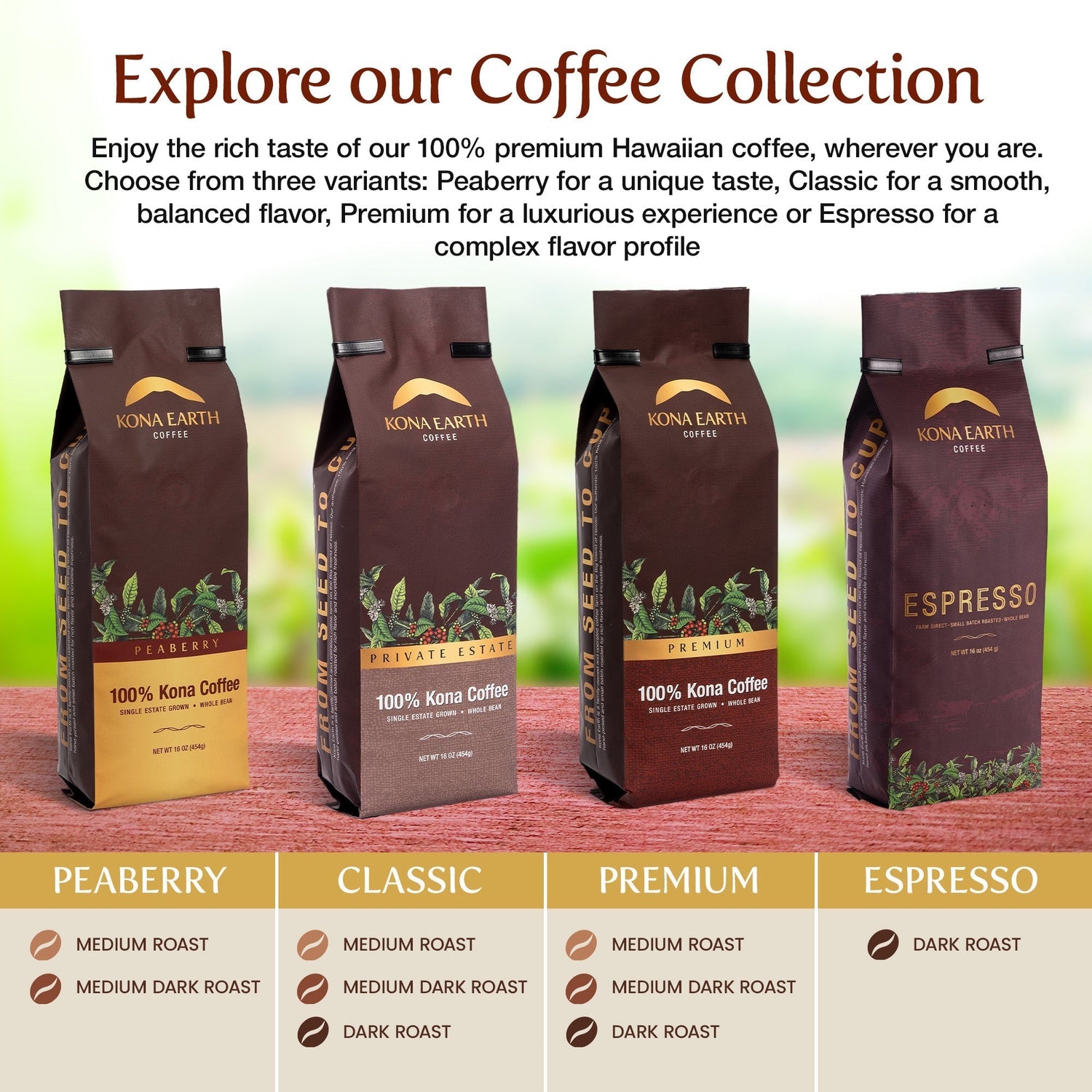Since adopting a plant-based lifestyle shouldn’t stop you from enjoying coffee, we’ve put together a guide on how to use plant-based milk with 100% Kona coffee.
A recent study into the eating and drinking habits of people living in the US suggested that over a third of us primarily drink plant-based milk over dairy milk. But since dairy milk complements coffee so well, how do you replicate that effect with vegan milk?
This guide will cover the best kinds of milk to add to filtered coffee, as well as how certain kinds of milk can froth if you want to make a latte or cappuccino-style drink.
What Makes a Plant-Based Milk Work Well With Kona Coffee?
Hawaiian Kona coffee is a specialty coffee that is naturally sweeter and lower in acidity than other coffee, so the purpose of milk is largely textural. You want milk that will give your drink a bit of extra body without affecting the flavor profile of the coffee too much.
A suitable plant-based milk for Kona coffee, therefore, has the combination of a relatively high fat and protein content and being as neutral or bland in flavor as possible.
Any plant-based milk that has a combined fat and protein content of over 2.5%, and which has a neutral to sweet-neutral flavor would therefore likely work well with Kona coffee. Such a combined fat and protein content would give the milk enough texture that a splash of it would noticeably impact the body of a cup of coffee and a neutral flavor means that it won’t overpower the coffee at all.
The other factor that affects how well milk works with coffee is the temperature at which it curdles and splits. Coffee is typically enjoyed at a temperature of around 140 Fahrenheit. Therefore if your milk curdles at a temperature lower than this, then you run the risk of your milk splitting and creating a strange speckled texture when you pour it into your coffee.

The table below shows the combined fat and protein content, flavor profile, and curdle point of the most commonly found dairy and non-dairy milk:
|
Type of milk |
Flavor profile (when unsweetened) |
Combinedfat and protein Content |
Curdle Point (temperature) |
|
Dairy |
Sweet-neutral |
6% |
180 Fahrenheit |
|
Soy |
Netural |
4.7% |
150 Fahrenheit |
|
Oat |
Sweet |
3.5% |
160 Fahrenheit |
|
Almond |
Sweet-neutral |
1.75% |
160 Fahrenheit |
|
Cashew |
Sweet-neutral |
6.9% |
150 Fahrenheit |
|
Coconut |
Nutty |
4.7% |
150 Fahrenheit |
|
Rice |
Sweet |
1.1% |
140 Fahrenheit |
|
Pea |
Neutral |
5.5% |
170 Fahrenheit |
What are the Best Plant-Based Milks to Have with Kona Coffee?
As we can see from the table above, the best plant-based milks to have with Kona coffee are oat milk, soy milk, cashew milk, and pea milk.
Each milk will give your coffee a slightly different taste and texture, so it's well worth experimenting with a few of these before deciding which one is ultimately best for you.
We have found that the majority of people prefer to have oat or pea milk with their coffee. The reason for this is that soy and cashew milk have curdle points that are only slightly higher than most people’s desired drinking temperature for coffee. Therefore, if you pour these kinds of milk into your coffee a few minutes before you want to drink it then they still run a high risk of splitting.
What are the Best Plant-Based Milks for Frothing?
For a milk to be good for frothing, it needs to have:
- At least 1% fat content
- At least 2% protein content
- At least 1% sugar content
- Be able to stand temperatures of over 150 Fahrenheit without curdling

The table below shows how each of the common dairy and non dairy milks fare in each of these categories:
|
Type of milk |
Sugar content |
Fat content |
Protein content |
Curdle Point (temperature) |
|
Dairy |
5% |
2.5% |
3.5% |
180 Fahrenheit |
|
Soy |
0.4% |
1.7% |
3% |
150 Fahrenheit |
|
Oat |
7% |
1% |
2.5% |
160 Fahrenheit |
|
Almond |
0.5% |
1.25% |
0.5% |
160 Fahrenheit |
|
Cashew |
1.25% |
4.5% |
1.9% |
150 Fahrenheit |
|
Coconut |
3.3% |
2.4% |
2.3% |
150 Fahrenheit |
|
Rice |
5% |
1% |
0.1% |
140 Fahrenheit |
|
Pea |
0% |
2% |
3.5% |
170 Fahrenheit |
Looking at the above table we can see that only oat milk and coconut milk fulfill these criteria.
Although coconut milk froths up really well from a textural standpoint, any drink that you make with it will have a distinct coconut flavor. While this is desirable to some (coconut milk lattes are becoming trendy), I still think it's a bit of a waste to have this type of milk with Kona coffee as it clashes with the already sweet flavor of the coffee itself.
Since soy and pea milk have the ideal amounts of fat and protein for frothing, but do not have enough sugar to make the sweet foam that you get from frothing dairy milk, sweetened versions of these milks can be really good for frothing. The sweetened version of soy milk is easy to find in most grocery stores.
Are Barista Milks Worth It?
If you have been drinking plant-based milk with coffee for some time then you may have seen specialized “barista” versions of plant-based milk.
Soy and oat milk seem to be the ones that most commonly have “barista” versions.
These “barista” milks have protein, fat, and sugar added to bring the proportion of these three components closer in line with dairy milk. This means that it will produce the same results as dairy milk when frothed. This is something that is particularly desirable for baristas who want to make repeatable milk-based coffee drinks without needing to froth each milk in a different way.
You should only buy barista milk if your primary use for the milk is to froth it. These kinds of milk are more expensive than regular plant-based milk and are not significantly better than “non-barista” plant-based milks when added straight to filter coffee.
If you are swapping out dairy for plant-based milk for health reasons, you should bear in mind that barista milks will not be significantly lower in fat or sugar than dairy milk.
Final Thoughts
Switching to plant-based milk doesn’t mean you have to give up having milk with your Kona coffee. Oat milk, pea milk and soy milk both can go excellently with Kona coffee, giving it the desired extra body without interfering with its flavor profile.
If you want to make milk-based drinks like latte and cappuccino, then we’d recommend opting for barista-style oat milk or barista-style soy milk.
If you'd like to buy single-estate, high-elevation, Kona coffee directly from a family-run farm in the heart of Kona, try Kona Earth.
**This article was submitted by Oli Baise. Oli is an experienced barista and runs coffee blog Drinky Coffee.


